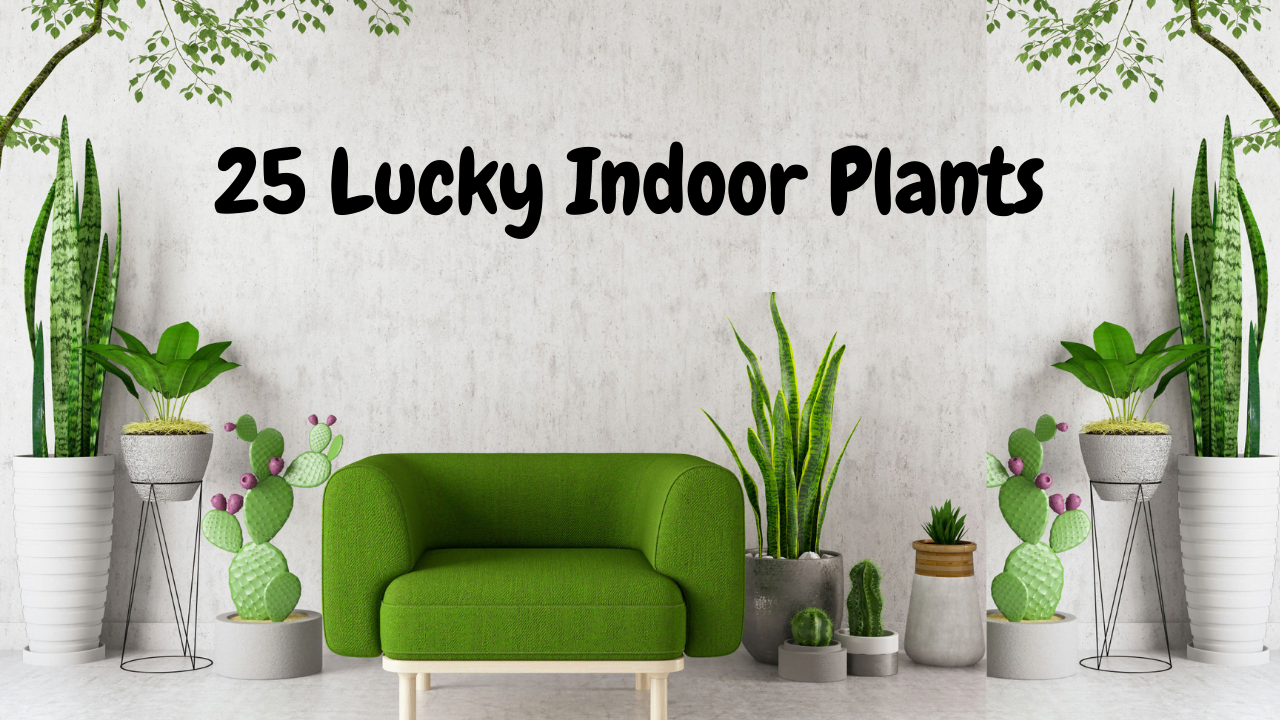Do you believe in luck? Can you think that your potted plant friend can help you with it?
Yes, lucky indoor plants for homes do exist! Keep reading as we list them for you.
Before that, here is a brief about feng shui and Vastu shastra—two major beliefs on welcoming positive energy in a space. These are based on interactions human beings have with their environment. And how can such interactions bring in propensity or wealth?
Certain indoor plants are special and bring more positive energy inside a space, according to feng shui and Vastu shastra principles.
Here are a few lucky indoor plants for home gardening and decoration!
| S.No | Name | Image | Description |
|---|---|---|---|
| 1. | Lucky Bamboo | Bamboo trees are promising; they symbolize Vastu shastra and Feng Shui luck. To attract wealth, place a set of 3 or 9 stalks of bamboo shoots on the Xun position or the left-most corner of your room from its entrance. | |
| 2. | Pachira Money Tree | Seven is a lucky number in Feng Shui; if you are lucky, you can make it yours. The leaves of the plants are mostly with an odd number of leaves, like 5 or 7. If you land a seven-leafed pachira money plant, grab the lottery! | |
| 3. | Pitcher plant | According to Feng shui, the pitcher plants’ pitcher organs resemble bags. These are meant to collect money and prosperity for the owners. These plants are associated with more fortune and luck!. | |
| 4. | Peonies | The peonies have beautiful, fluffy, and luscious flowers symbolizing good luck, love, fertility, and success. It is fortunate to have the peonies blooming as they mean a prosperous new beginning. | |
| 5. | Orchids | These are one of the beautiful lucky indoor plants for homes and offices. They have vibrant colored large flowers. The flowers of the plants enhance luck when grown in homes. It also boosts harmony and understanding in relationships. | |
| 6. | Peace Lily | A white lily signifies purity and peace. Feng Shui highly recommends these plants for peaceful and calm energy in homes and offices. | |
| 7. | Citrus | According to Feng Shui these citrus plants bring lots of luck and prosperity. It is also considered a cure for its medicinal value. | |
| 8. | Lavender | It brings in love and money when grown indoors. The plant has a beautiful scent that helps calm nerves and promotes a peaceful environment in the house. These are among the best lucky indoor plants that elevate your mood and help you sleep better when grown inside. | |
| 9. | White Narcissus | It is a type of daffodil and is popular in Feng Shui culture. The white flowers and bulb nature symbolize more cash flow and wealth. | |
| 10. | Aloe vera | These succulent plants are famous for the gel it produces. They compact the bad energy and negativity. The plant’s medicinal value promotes positivity in any house or office environment. | |
| 11. | Golden Pothos | These are among the best-looking lucky indoor plants for home and office interiors. They are famous for their air-purifying property and radiate energy for wealth and prosperity. | |
| 12. | Jade plant | They are famous in Asian countries for their luck in financial and monetary matters. The plant’s leaves resemble jade stones and reflect more revenue when grown in homes and offices. | |
| 13. | Carmona Bonsai | They bring in good luck, prosperity, and charm when grown indoors. They also re-energies the positive energy within the house or office interiors. | |
| 14. | Adenium | In Chinese culture, these plants are famous for attracting wealth. They symbolize the swollen roots of these plants for abundance and fertility. | |
| 15. | Cactus | Though still there are some myths about bad energy, with its endurance, we believe they are a charm to grow at home. They symbolize endurance, toughness, and persistence. Gifting a cactus plant is supposed to encourage the receiver to fight and stay motivated in tough situations. | |
| 16. | Sage | The stripes in the sage leaves are believed to remove bad influences from the house. Burning sage leaves are also considered to remove bad spirits away. | |
| 17. | Bonsai Banyan | In Feng Shui, the bonsai banyan trees are famous for the luck and positive vibes they bring in. The unique appearance of the plant also adds a beautiful aura to complement the plant’s positivity. | |
| 18. | Shamrock Plant | The plant’s leaves are clover in shape, and many associates these shapes with luck and charm. An Irish tradition is to add these plants to the bride and groom’s bouquet to welcome luck and prosperity in life. | |
| 19. | Paper Plant | Paper plants are easy to grow, and the leaves symbolize luck and fortune in Feng Shui. The plants grow indoors, though they are best outdoors. With full light and air circulation | |
| 20. | Snake Plant | The snake plant must be placed in a secluded spot in your home to bring in more positive vibes to the house. It also purifies the air and makes the environment healthy. | |
| 21. | Rubber Plant | The plant is famous for its austerity and auspiciousness in financial matters. They are believed to bring in more fortune when grown as a houseplant. | |
| 22. | Palm Plant | The plant is famous for the positive vibes and prosperity inside the residence. The distinctive leaves also add great value to the indoors. | |
| 23. | Eucalyptus | The beautiful aroma from these plants is believed to invite better health and prosperity. | |
| 24. | Ficus ginseng | Feng Shui treats the ficus ginseng plants as a symbol of good luck. The air purifying nature of the plant boosts the natural environment within the house. When you breathe better, you live better. | |
| 25. | Tulsi or Basil | The medicinal value of plants for all body ailments boosts the positivity of the plant. Different cultures celebrate these plants for their medicinal value. They also keep away pests when grown as a houseplant |
25 Lucky Indoor Plants
1. Lucky Bamboo
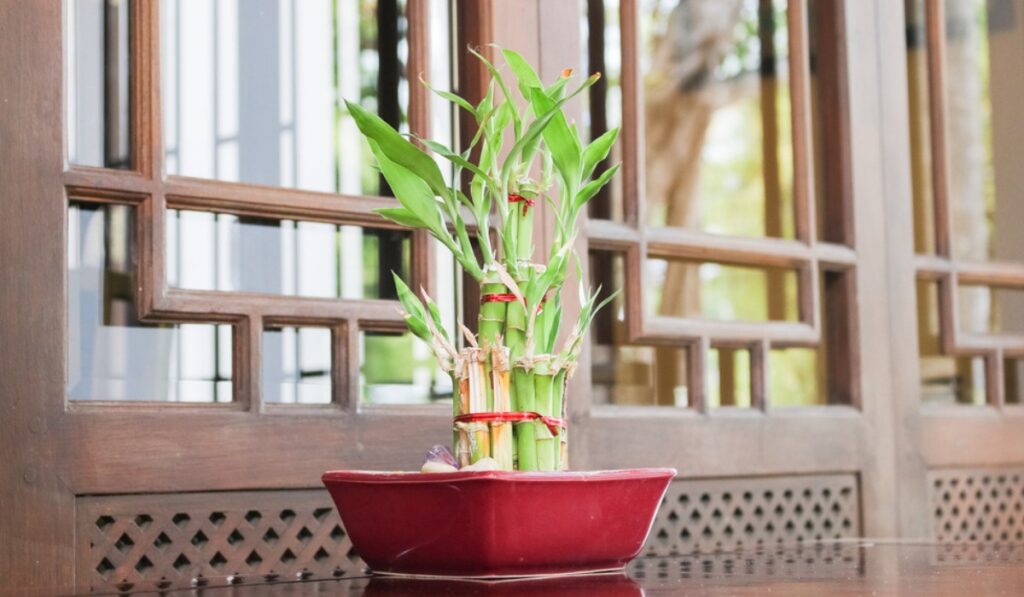
Botanical name: Dracaena sanderiana
| Height | 1 – 3 feet |
| Width | 1 – 2 feet |
| Sunlight | They tolerate light shade and indirect lighting |
| Watering | Water thorough for every 7 – 10 days |
Since these are tall plants, it would be best to plant them in a tall vase filled with stones, organic soil, and water to maintain their stability. Always place the bamboo in a warm place with indirect lighting. Avoid direct sunlight. Keep changing the water every week if these lucky bamboo plants grow in a water and stone vase. Feed liquid fertilizers once every month.
2. Pachira Money Tree
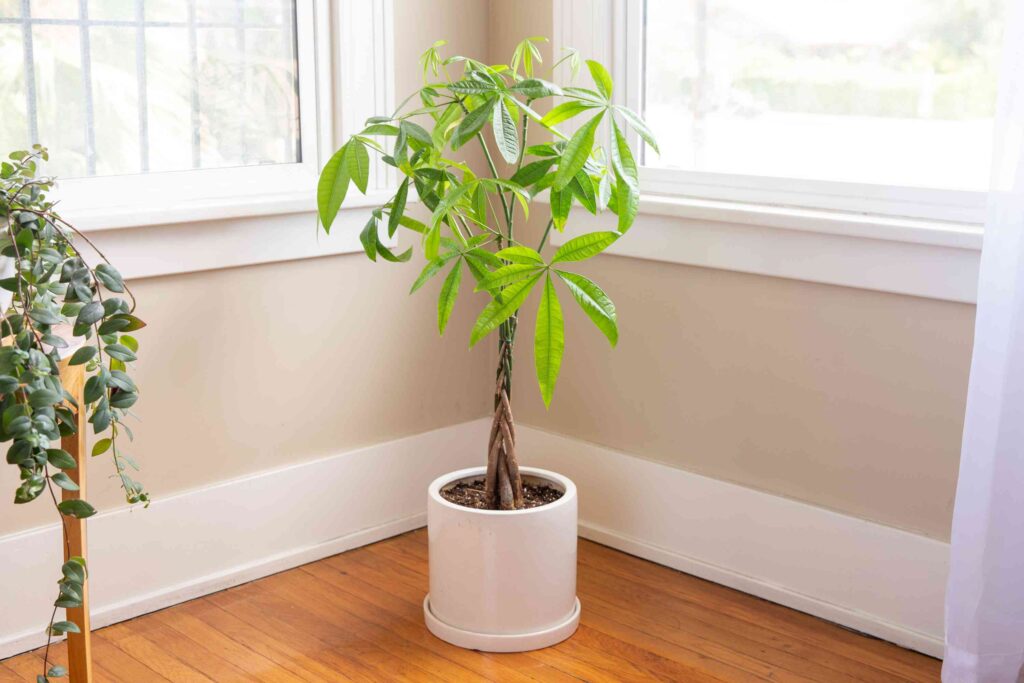
Botanical name: Pachira aquatica
| Height | 3 to 6 feet |
| Width | 1 to 2 feet |
| Sunlight | Bright indirect light. Direct sunlight will burn the delicate leaves |
| Watering | Water thorough for 1 or 2 times per week |
The pachira money trees can be a central focus in your interiors. Its braided stems and leaves cluster as sets of 5 or 7 at the end of the stems. Feng shui strongly believes that these plants bring luck and fortune—a perfect gift option for office decoration or a housewarming present.
3. Pitcher Plant
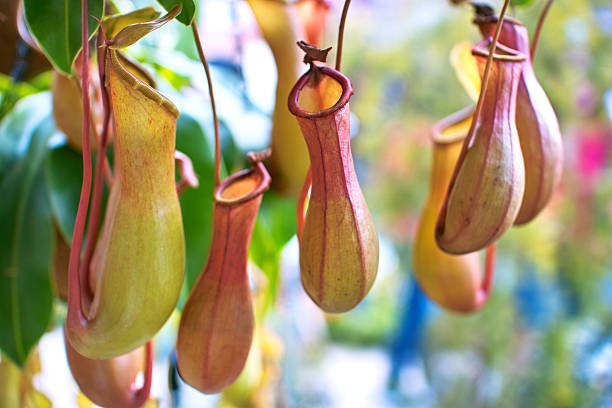
Botanical name: Nepenthes
| Height | 4.9 feet |
| Width | 1 feet |
| Sunlight | Full sunlight to light shade |
| Watering | Water thorough for every 3 – 4 days |
The best temperature to grow a pitcher plant would be around 16 – 21 degrees celsius. These plants require minimal care and can easily be grown in your window sills. Don’t forget to feed these plants good orchid food from the growing season onwards.
These carnivorous plants absorb nutrients from the insects they trap using their pitcher organs. Before locating your pitcher indoors, check if it’s well lit and has access to frequent bugs and insects.
4. Peonies
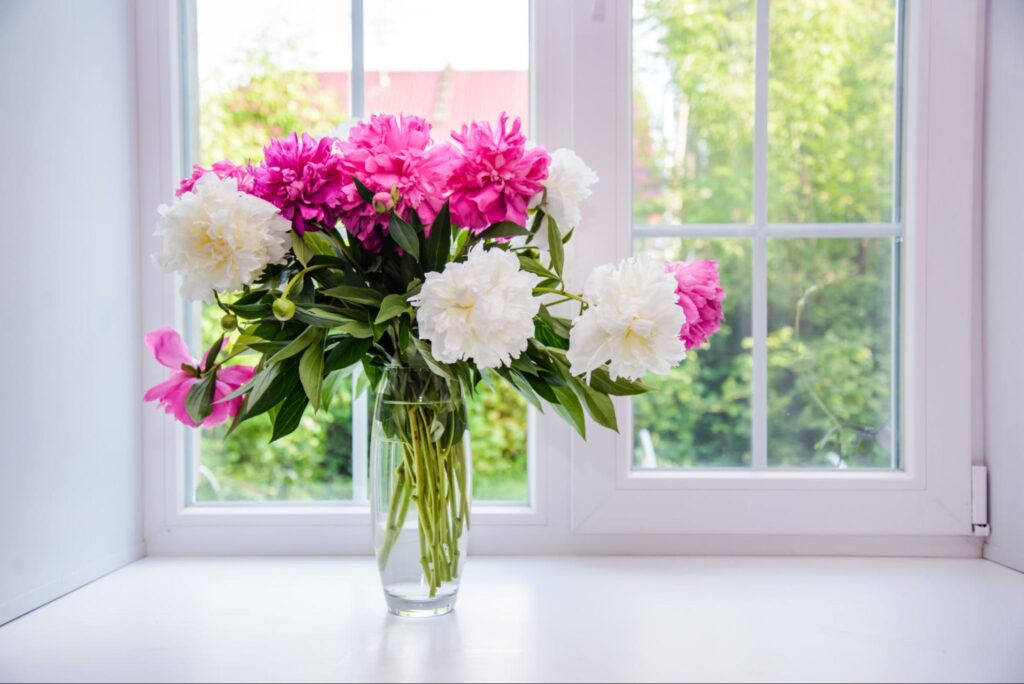
Botanical name: Paeonia
| Height | 1 – 3 feet |
| Width | 3 – 8 feet |
| Sunlight | 6 – 8 hours of sunlight daily |
| Watering | Water them once every 2 weeks |
It would be best to provide well-draining soil to grow your peonies. These plants need lots of water; if the soil is not well-draining, it can waterlog your plant pot. Avoid water loss through evaporation to encourage blooming in peonies. You can also cover a plastic wrap around the bud till its stem to achieve blooming, concealing the flowers’ moisture.
5. Orchids
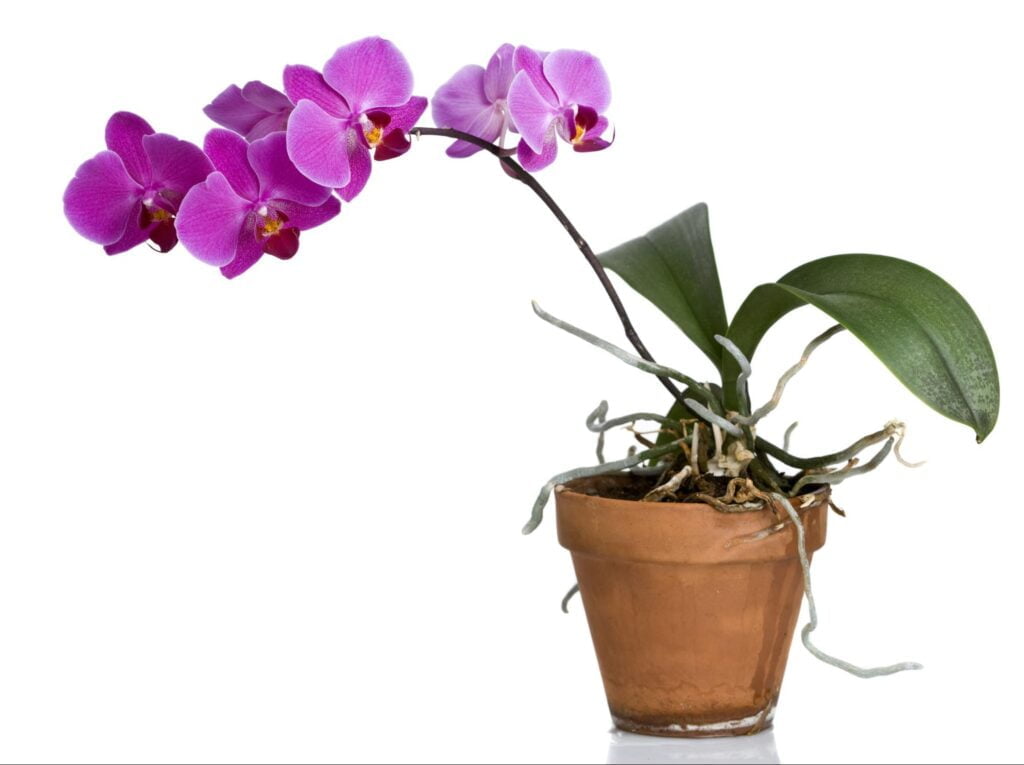
Botanical name: Orchidaceae
| Height | 1 – 3 feet |
| Width | Around 1 feet |
| Sunlight | Bright indirect sunlight |
| Watering | Water them once every 7 – 10 days |
Most Orchid plants prefer to grow in a high humid environment. They require regular intervals of heavy watering and drying periods to thrive better. If your home is dry, place a water tray below the plant pot to ensure the roots always have humid air.
6. Peace Lily
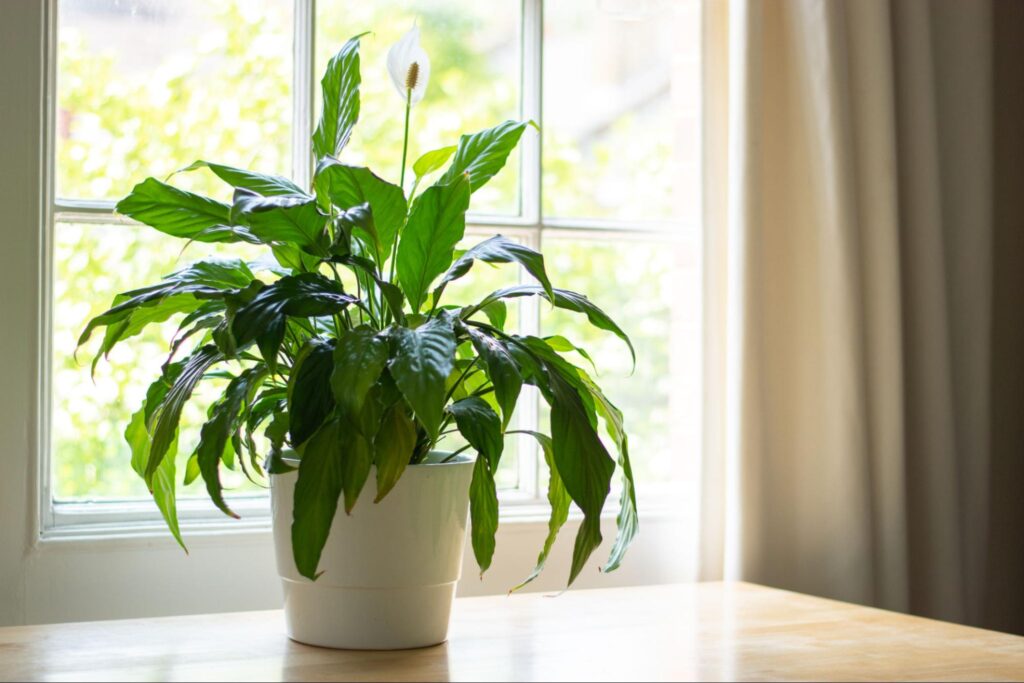
Botanical name: Spathiphyllum
| Height | 2 – 3 feet |
| Width | 4 -5 feet |
| Sunlight | Partial shade and cannot tolerate fluorescent lights |
| Watering | Water them once a week |
The stems of the peace lily plants often grow long and look stretchy when trying to reach more light (growing leggy). They need a good amount of light to grow in a proper size. If it grows, change the plant’s location to a more bright and well-lit zone.
As for flowering, make sure you provide sufficient water to your plants. They bloom only when the soil is moist and warm.
7. Citrus plants
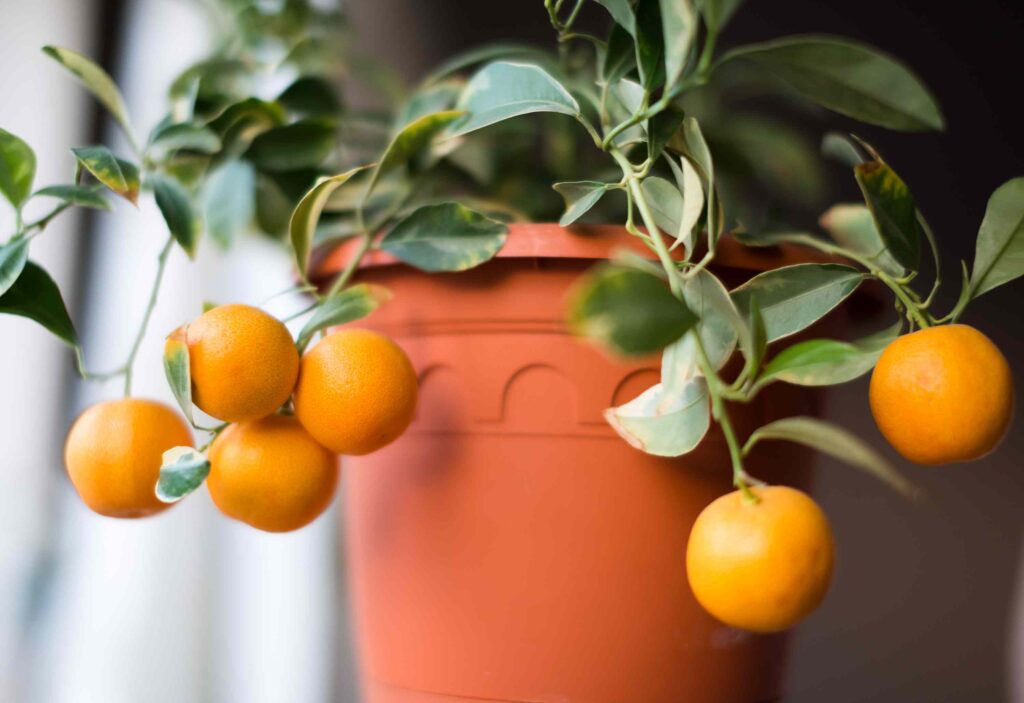
Botanical name: Citrus
| Height | 25 – 30 feet |
| Width | 4 -5 feet |
| Sunlight | 5 hours of good sunlight |
| Watering | Water them twice a week |
To grow citrus plants fast, make sure you feed them fertilizers frequently. They absorb the soil nutrients very quickly and need more fertilizer to balance the soil fertility. It would be best to fertilize the plant with any nitrogen-rich organic fertilizer every month or two.
Also, keep the plants in a warm location as these plants cannot withstand temperatures below 50 degrees Fahrenheit.
8. Lavender
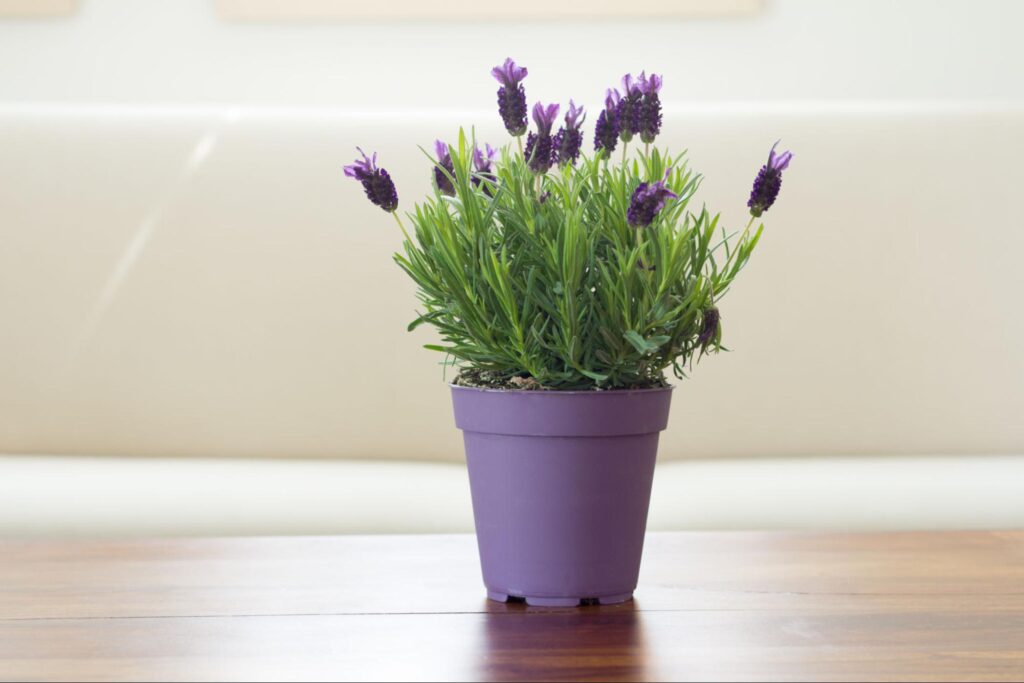
Botanical name: Lavandula
| Height | 2 – 3 feet |
| Width | 2 – 4 feet |
| Sunlight | 5 – 6 hours of good sunlight |
| Watering | Water them once or twice a week |
Lavender plants are easy to grow once the growth is established. They are effortless to grow once you place them in a sunny home spot. Please provide alkaline and well-draining soil to avoid waterlogging in the plant pot.
9. White Narcissus

Botanical name: Narcissus papyraceus
| Height | 1 – 2 feet |
| Width | 0.5 – 1feet |
| Sunlight | Full and partial sunlight |
| Watering | Water them twice a week |
Keep the soil moist and well-drained to encourage blooming in the white narcissus plants. These plants bloom within 3 or 4 weeks when ideal conditions are there. Once they bloom, you can keep the soil moist and place the flowers in a sunny location to encourage them to live longer.
10. Aloe vera
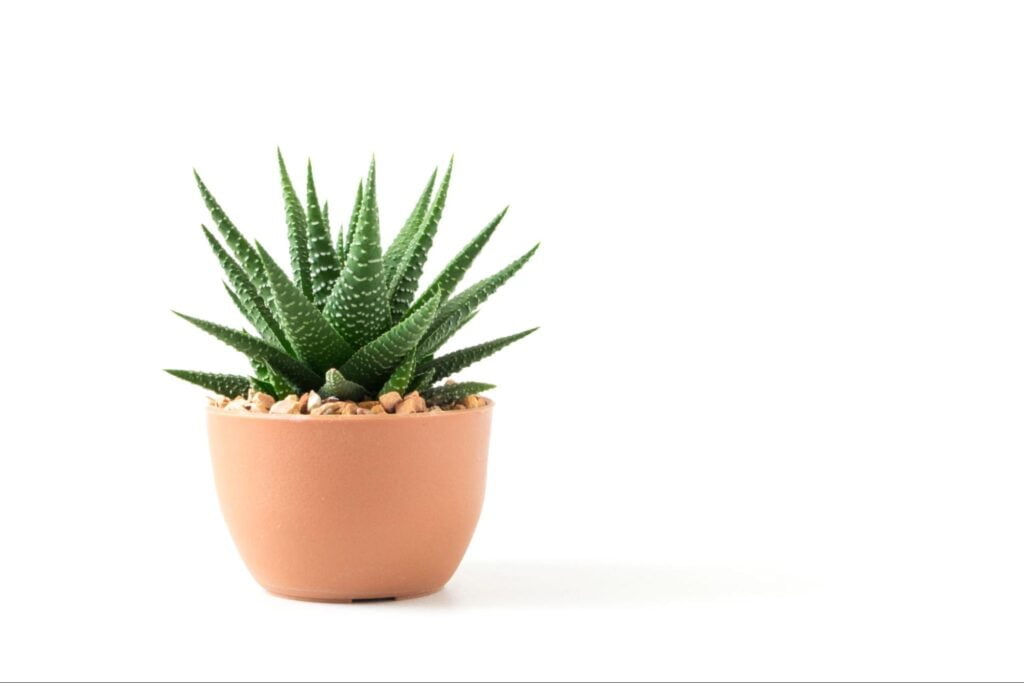
Botanical name: Aloe barbadensis miller
| Height | 1 – 2 feet |
| Width | 2 – 3 feet |
| Sunlight | Bright sunlight for 6 – 8 hours daily |
| Watering | Thoroughly water them, but only do it once or twice a month. |
As the Aloe vera plants belong to the succulent variety, it would be best to avoid overwatering them. Let the plant enjoy the maximum sun; if not, they might go dormant. Water thoroughly at long intervals. Avoid water logging the plants as they might end up developing root rots.
11. Golden Pothos

Botanical name: Epipremnum aureum
| Height | 20 – 40 feet |
| Width | 3 – 6 feet |
| Sunlight | Bright indirect sunlight |
| Watering | Water every 1 or 2 weeks |
Golden pothos need lots of water, sunlight, and fertilizers as a tropical plant. The most common trouble will be watering and fertilizer. Make sure you fertilize using compost or liquid seaweed solution once or twice a month. Feeding the soil boosts the foliage growth and makes it look fuller.
12. Jade plant
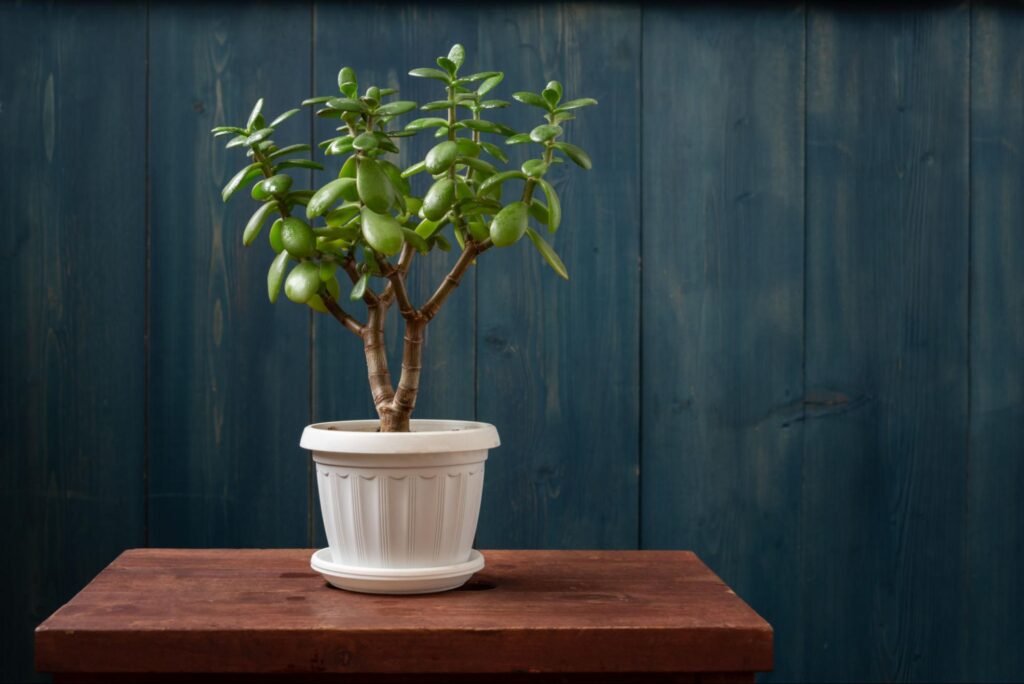
Botanical name: Crassula ovata
| Height | 6 feet |
| Width | 3 feet |
| Sunlight | Bright 6 hours of daily sunlight |
| Watering | Water every 2 or 3 weeks |
The succulent, fleshy, light green leaves of the jade plants look the best when the plant grows bushy. To make the foliage thick, you can try pruning the shoot tips regularly help the stem to encourage growth below the cut tip. Doing so makes the plant grow thicker and bushier.
13. Carmona Bonsai
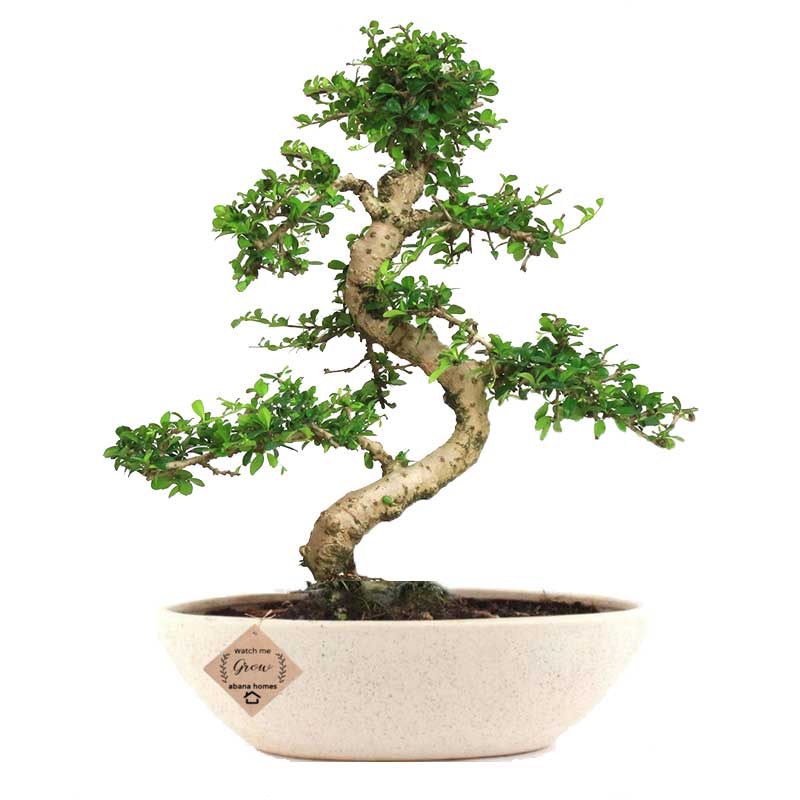
Botanical name: Carmona retusa
| Height | 6 to 29 inches |
| Width | 8 to 16 inches |
| Sunlight | Indirect sunlight or shade location |
| Watering | Every two or three days |
Maintaining soil moisture is so important. Carmona bonsai plants don’t like too much wetness or drought. Fertilize the plant twice a month during the growing season. Please carefully water the soil before spreading the fertilizers to avoid root burns.
14. Adenium
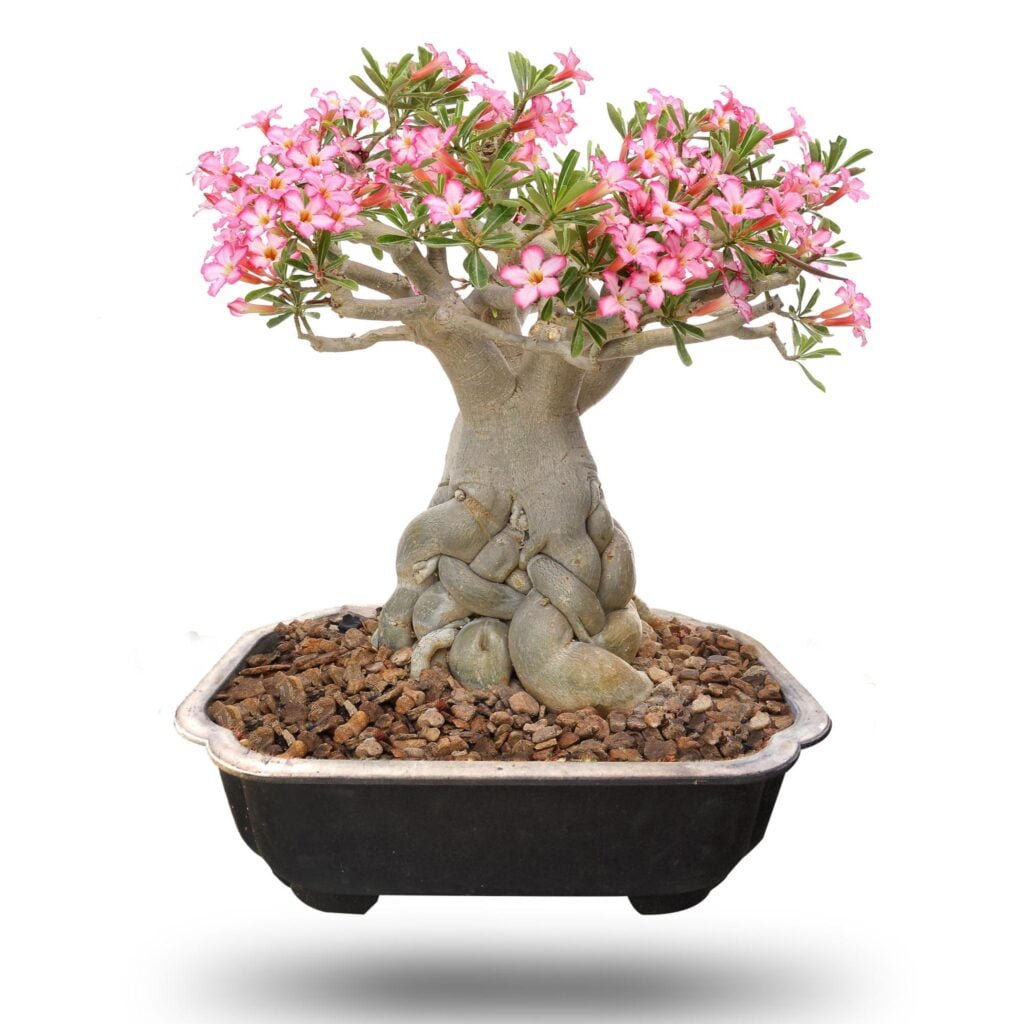
Botanical name: Adenium obesum
| Height | 4 to 6 ft |
| Width | 1 to 2 ft |
| Sunlight | Full direct sunlight |
| Watering | Daily watering. However, skipping one or two days is also acceptable. |
To encourage the best growth:
- Make sure you fertilize the soil frequently.
- Use a diluted 20-20-20 liquid fertilizer once a month to promote growth.
- Avoid feeding them during winters.
15. Cactus
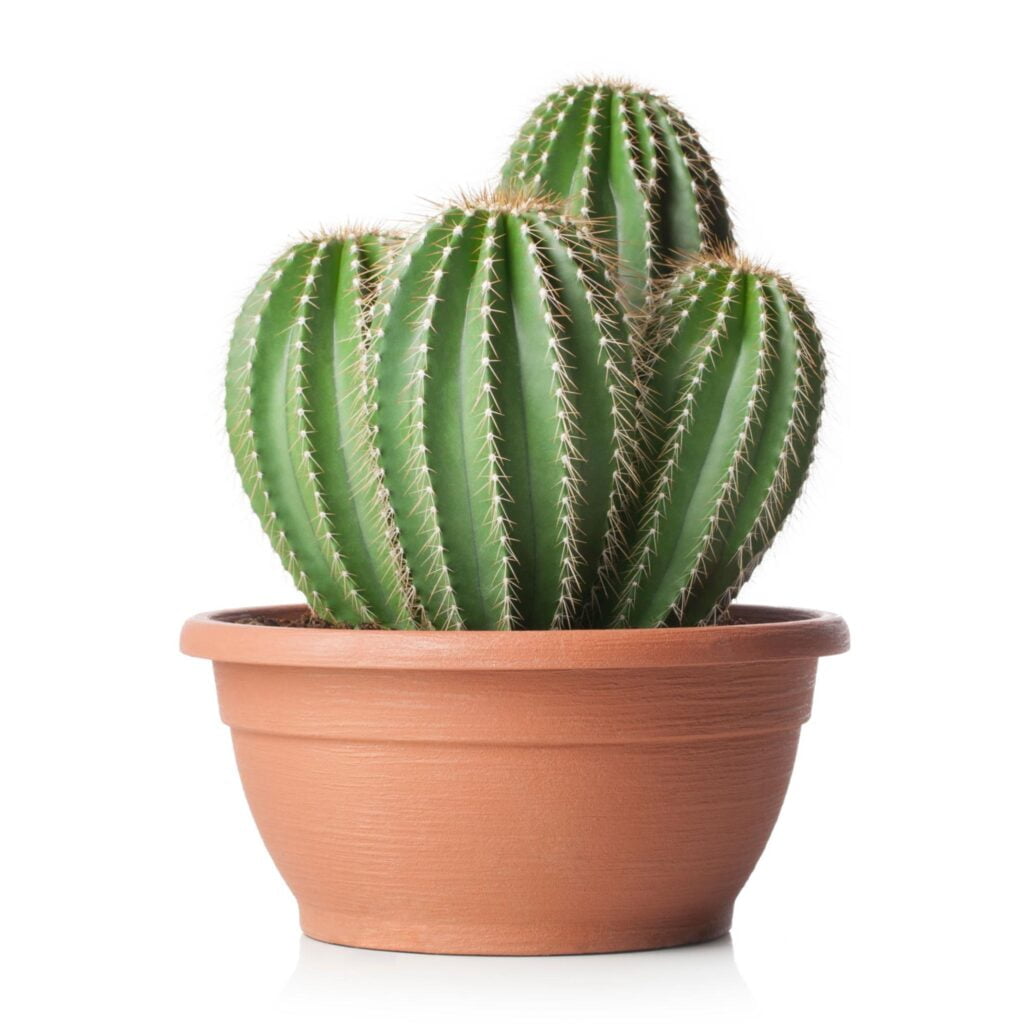
Botanical name: Cactaceae
| Height | 1 to 8 feet |
| Width | 12 to 18 inches |
| Sunlight | Full direct sunlight |
| Watering | Drought resistant. Water every two to three weeks |
If you want your cactus plant to grow faster, give them lots of sunlight, air and fertilizers. Water the plant when needed. Avoid over-watering. Fertilize them only during the growing season. Let them go dormant during the winter season.
16. Sage
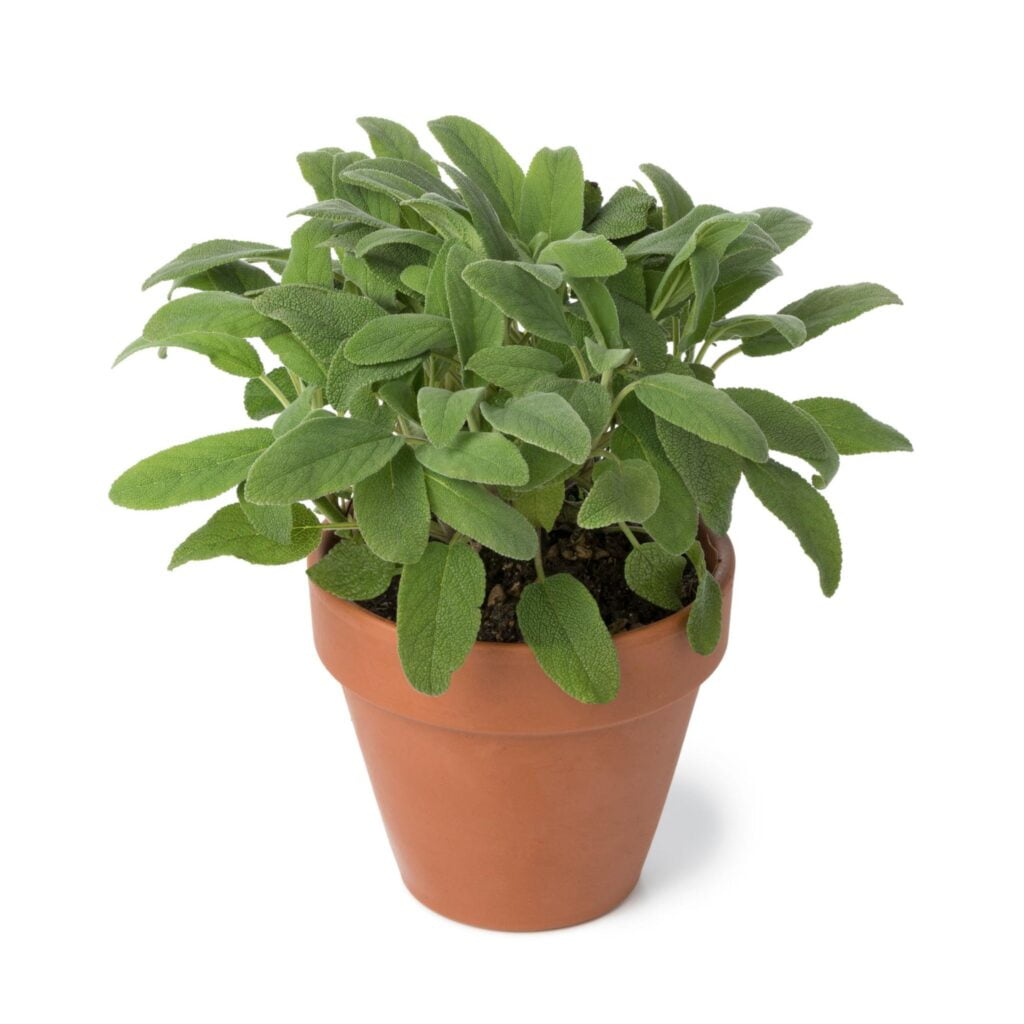
Botanical name: Salvia officinalis
| Height | 1 to 3 feet |
| Width | 2 to 3 feet |
| Sunlight | Warm and full direct sunlight |
| Watering | Water moderately. Once or twice per week |
If you plan to grow a herb at home, then sage can be a great addition to your plant collection. It’s a part of the mint family and grows well in containers at room temperature. They are easy to grow and look great indoors.
17. Bonsai Banyan
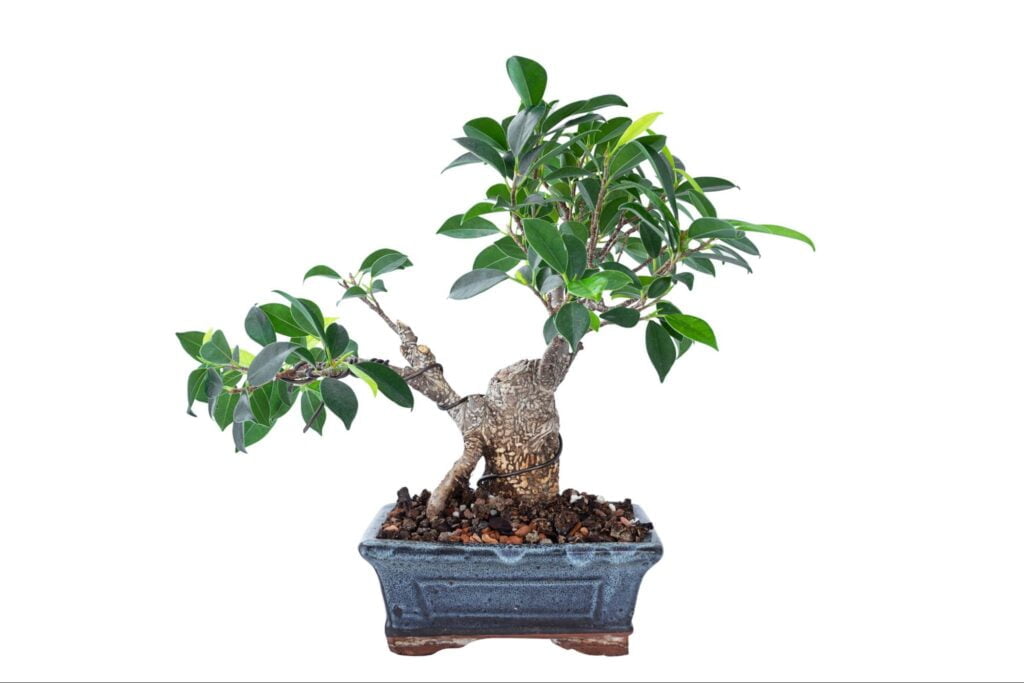
Botanical name: Ficus Benghalensis
| Height | Reach upto 2 feet |
| Sunlight | 5 – 6 hours of daily sunlight |
| Watering | Water before the soil goes dry. Watering once in 5 – 7 days |
If you’re planning these bonsai banyan trees indoors, make you place them away from hot spots. The plant enjoys sunlight and a humid atmosphere. Please water regularly, but avoid over or under-watering them.
18. Shamrock Plant
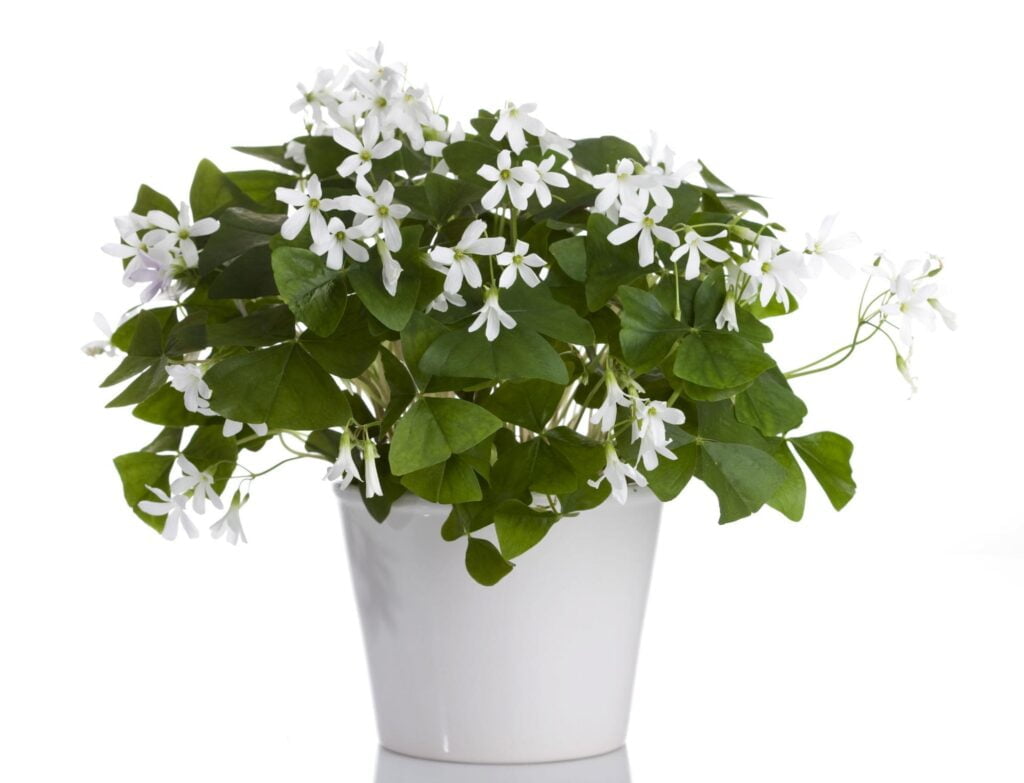
Botanical name: Trifolium dubium
| Height | 0.5 – 1 feet |
| Width | 1 – 2 feet |
| Sunlight | Bright and indirect sunlight |
| Watering | Water them regularly twice, or thrice a month. However, they do thrive decently in dryness. |
To make the Shamrock plant thicker, fuller and bushier, try moving them to a well-lit yet cool spot. You don’t want to burn the plant leaves. Water the plant regularly, though don’t overwater them. You can use fertilizers after you water these plants.
19. Paper Plant
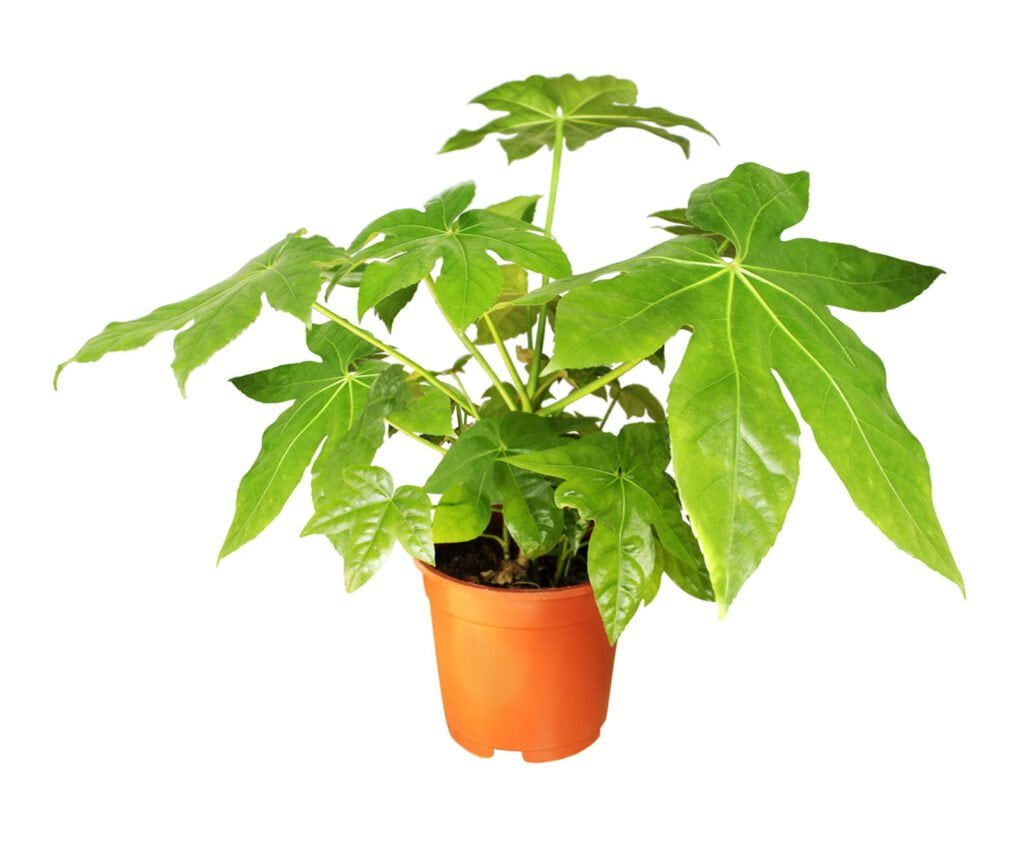
Botanical name: Fatsia japonica
| Height | 12 feet |
| Width | 5 – 8 feet |
| Sunlight | Indirect sunlight or shade |
| Watering | Water the soil when it is 50% -70% dry. Don’t over water them |
Preferred growing conditions of the paper plant include moist but well-drained, acidic soil that is rich in organic matter. The paper plant will tolerate sandy or heavy clay soils, moderate drought, and air pollution despite its preferences. They will grow well even in deep shade.
20. Snake Plant

Botanical name: Dracaena trifasciata
| Height | 1 – 3 feet |
| Width | 3 – 8 feet |
| Sunlight | Bright light but not strong direct ones |
| Watering | Water once in 15 days |
To promote faster growth in your snake plant, choose the right pot, provide the correct amount of water, give it lots of sunlight, fertilize regularly, and be on the lookout for pest infestations. Adequate bright light and little fertilizer will help your snake plant produce green leaves.
21. Rubber Plant
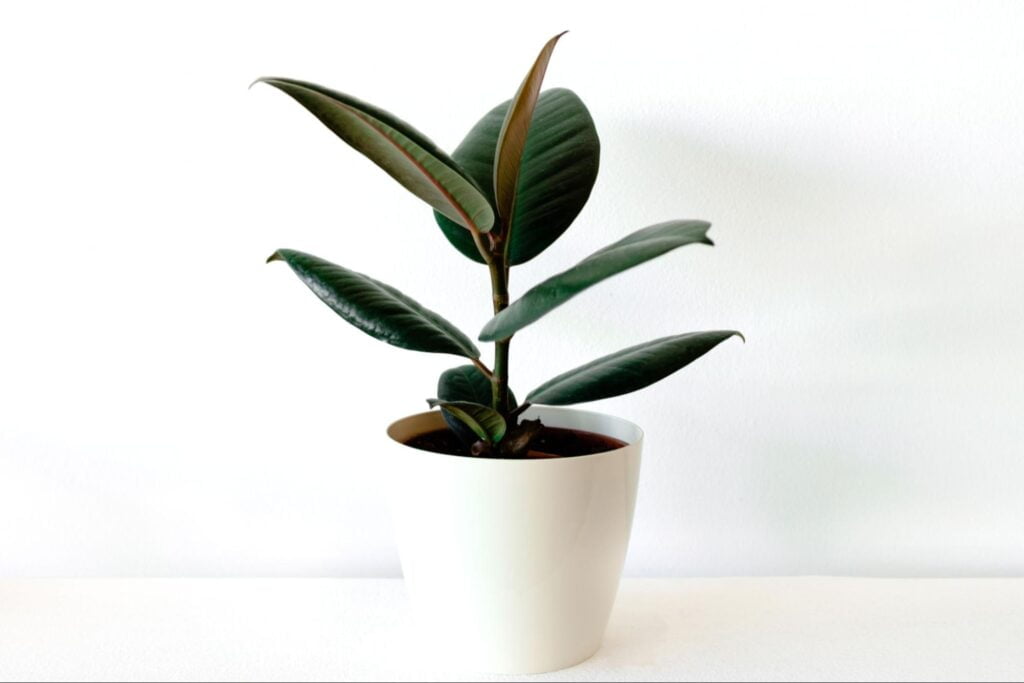
Botanical name: Ficus elastica
| Height | 8 – 10 feet |
| Width | 2 – 4 feet |
| Sunlight | Bright light is required |
| Watering | Water every 1 or 2 weeks |
Rubber Plants are quick growers, growing as many as 24″ in a season! Rubber Plants are not self-supporting; the longer they grow, the droopier they get. You can keep your rubber plant standing upright by using bamboo or dowels. I just use the leaves to hold it in place.
22. Palm Plant
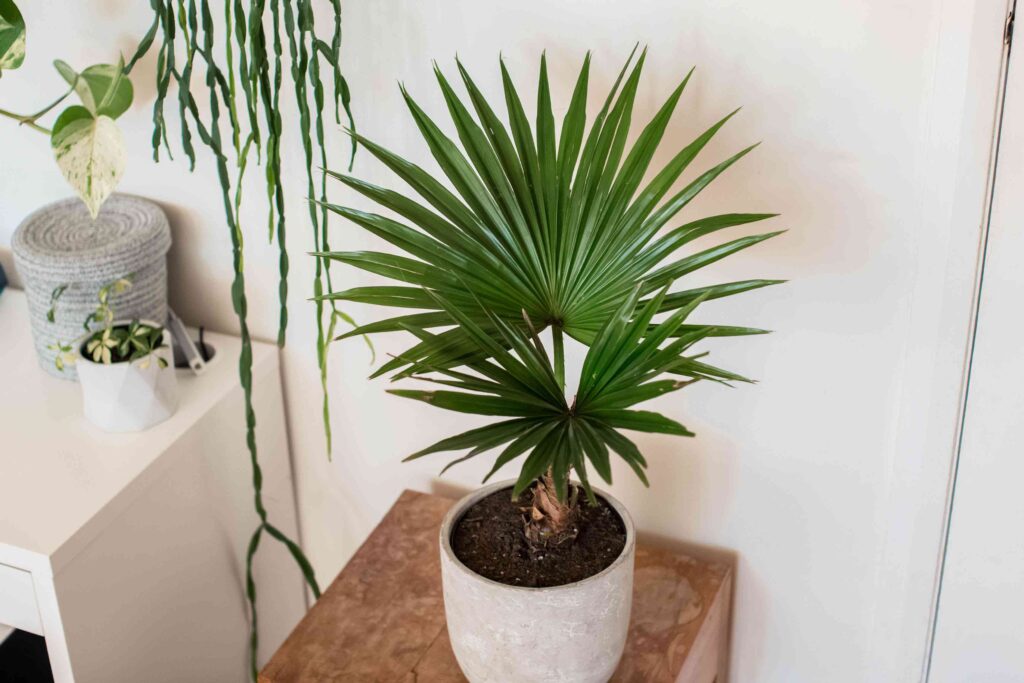
Botanical name: Dracaena trifasciata
| Height | 1 – 3 feet |
| Width | 3 – 8 feet |
| Sunlight | Bright light but not strong direct ones |
| Watering | Water once in 15 days |
The palm plants can tolerate dry and drought climates. They can manage high temperatures. However, they don’t tolerate over watering and soggy soily. It’s best advised to leave the plants in a sunny pot and water when the soil starts to dry. Keeping the soil moist makes sure that the plants grow fast and healthy.
23. Eucalyptus Plant
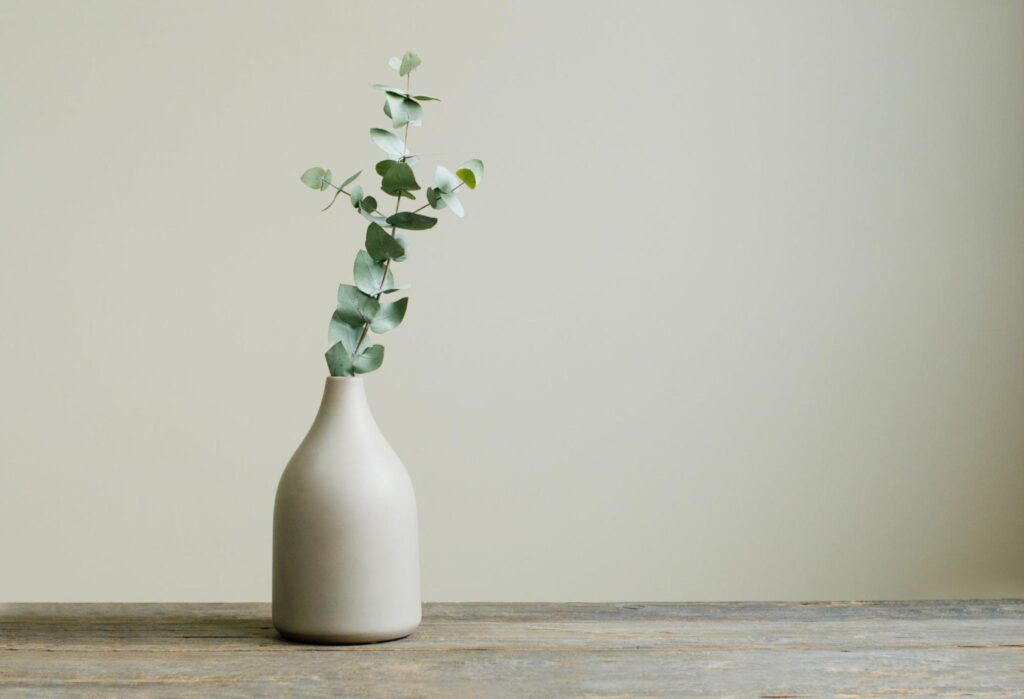
Botanical name: Eucalyptus
| Height | 8 – 20 feet or more |
| Width | 20 feet or more |
| Sunlight | 8 – 10 hours of full sunlight |
| Watering | Mature plants need watering once in 7 – 21 days |
The Eucalyptus plants are famous for their fast growth. They have grown 90% in almost 15 years. The eucalyptus gunnii variety is a slow-growing variety and can be grown indoors. These plants are highly celebrated for their medicine value.
24. Ficus Ginseng Plant
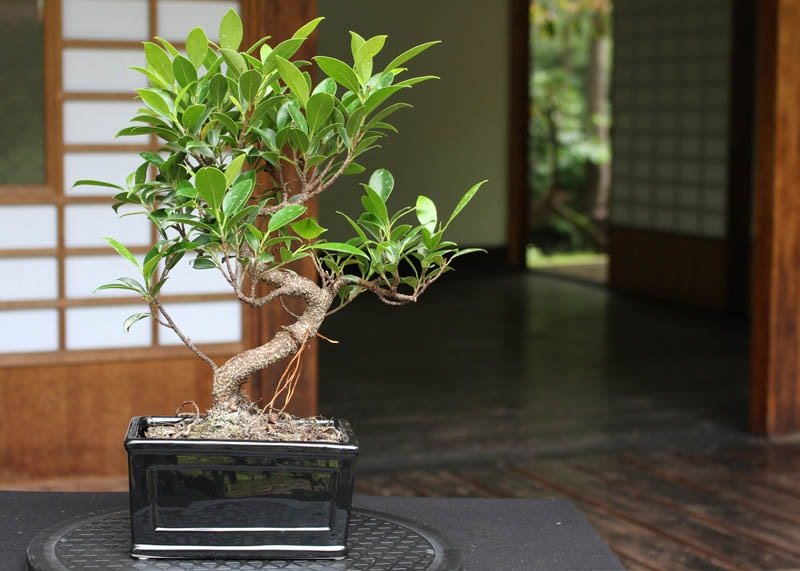
Botanical name: Ficus malacocarpa
| Height | 1 – 2 feet |
| Width | 1 feet |
| Sunlight | Bright light but not strong direct ones |
| Watering | Water once every 2 or 3 week |
Growing the ginseng ficus indoors is easy. They need minimal care and maintenance. Water your ginseng plants regularly once you notice the soil starts drying up. Though they grow well indoors, placing them outdoors or under indirect sunlight will promote better growth.
Misting can help the plant enjoy the humid environment and facilitates better growth.
25. Tulsi Plant

Botanical name: Ocimum tenuiflorum
| Height | 2 – 4 feet |
| Width | 1 – 2 feet |
| Sunlight | They require 6 – 8 hours of sunlight |
| Watering | Water the plant daily for better growth |
To speed up the tulsi plant’s growth, ensure you provide them with a good amount of direct sunlight and daily watering. Farm fertilizer and compost can also be added monthly to promote healthy growth.
FAQs
Why Jade plant is considered a lucky plant?
Jade plants, with their lush and sleek leaves resembling a healthy chubby infant arm, and in Eastern culture babies are symbolized as a positive sign. This is why they are called ‘Dollar Plant,’ ‘Lucky Plant,’ and ‘Friendship Tree,’ and it’s clear that all of them are associated with good luck. In Fengshui, these plants are believed to emit positive ‘chi’ or energy, aligning with the natural forces. This energy, along with Chinese Kungfu, makes jade plants symbolic of fortune and prosperity. They are often given during housewarmings, particularly to businessmen, and are strategically set at doors of Chinese institutions to draw luck, customers, and prosperity.
How do palm plants bring luck and positivity?
Palm plants are considered to attract positive energy and good luck. Above their aesthetic appeal, these plants also contribute to a healthier indoor environment by filtering the air.
Are rubber plants good for feng shui?
Rubber plants symbolize abundance, joy, and prosperity. According to the instructions of feng shui the rubber plant’s rounded leaves make it an excellent candidate to be set in a corner in order to mute the sharp angles. The wealth corner of the house is extremely suitable.
Why orchids are considered the best gift?
Orchids have long been viewed as signs of virtue, wealth, and good health but were also once believed to obtain pleasure and good luck to those who cultivated them. These are the reasons why it is tough to ever go wrong and be misunderstood when you are offering orchids to somebody.
What are the benefits of peace lily at home?
Peace lilies are positioned higher when we are talking about lucky plants, but along with that peace lilies are known for having many other benefits, such as purifying air, absorbing acetone vapors, promoting restful sleep, preventing mildew formation, removing mold spores from the air, and of course being ornamentally pleasing.
Which plant is considered lucky in Vastu?
According to Vastu Shastra, positioning the lucky Bamboo plant in the east or southeast corner of the home is believed auspicious. Particularly, placing it in the southeast direction is considered to draw fortune and prosperity. To improve its positive energy, bind a red ribbon around the plant, the red ribbon representing the fire element, while the bamboo itself symbolizes the wood element.
Which plant removes negative energy?
Calatheas are known to have incredible absorptive properties, freeing the air of negativity and spitefulness. Another unique feature of the plant is its capability to close the leaves in darkness and spread them again in the morning. Just like a baby resting, these plants have the magnificence to filter the air near them.
Conclusion
The beliefs are based on the people’s tales and the plants’ values. These lucky indoor plants symbolize luck from the medicinal value, fragrance, botanical structure, etc. The luck and charm roots back to a logical approach in most cases. Apart from chance, it’s worth growing these vibrant plants indoors.
If you believe in luck or not. Growing these plants will make your home look and feel great! Hope this article helped you choose the best plant that suits you and your house best.
May these lucky indoor homes brighten up your life and the days ahead.
Related Articles
- Propagating Chinese Elm Bonsai Cuttings And From Seeds
- Best Chinese Elm Bonsai Soil and Fertilizer.
- Troubleshooting Common Problems With Chinese Elm Bonsai
- Buy Chinese Elm Bonsai: How Not to Get Scammed When Purchasing a Chinese Elm Bonsai Tree!
- Chinese Elm Bonsai Pruning And Styling.
- Creating a Chinese Elm Bonsai Forest- Step-By-Step Guide.

